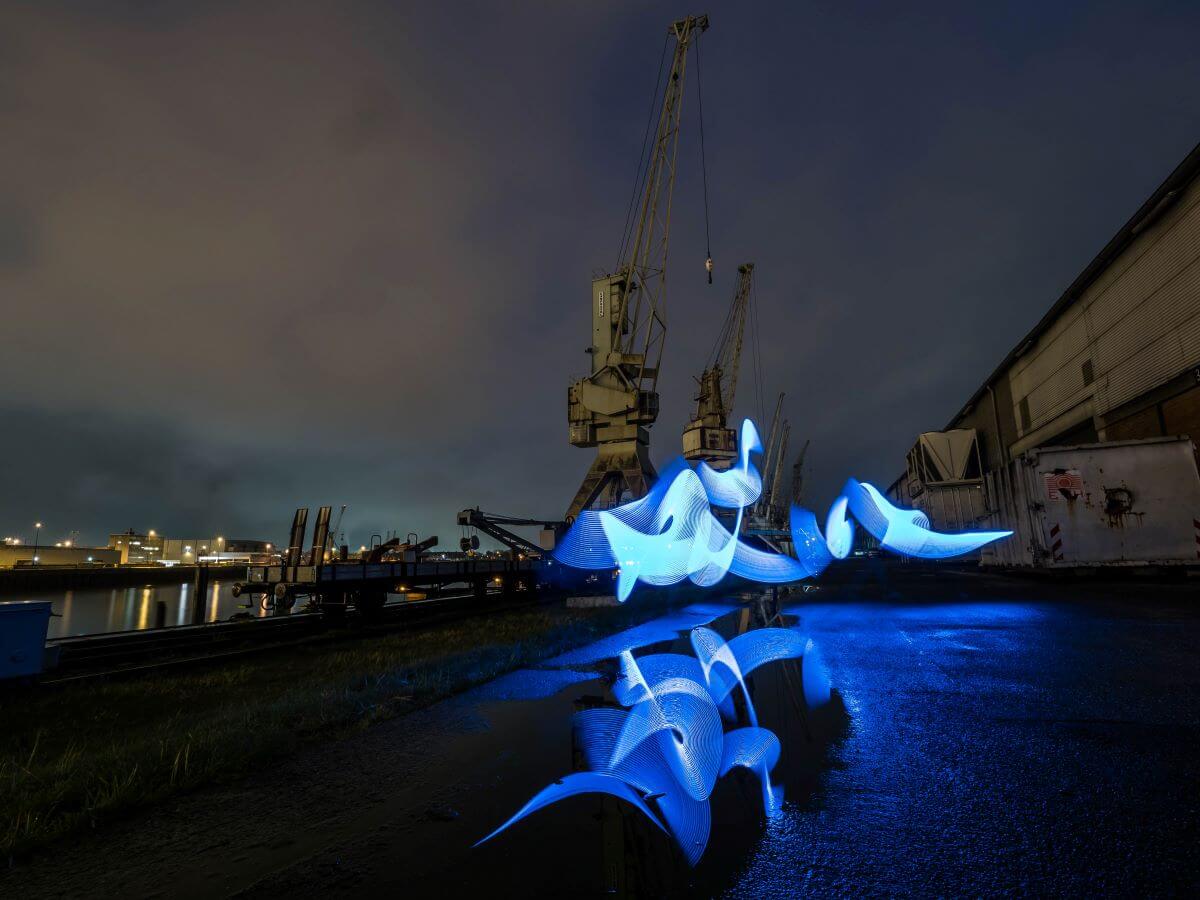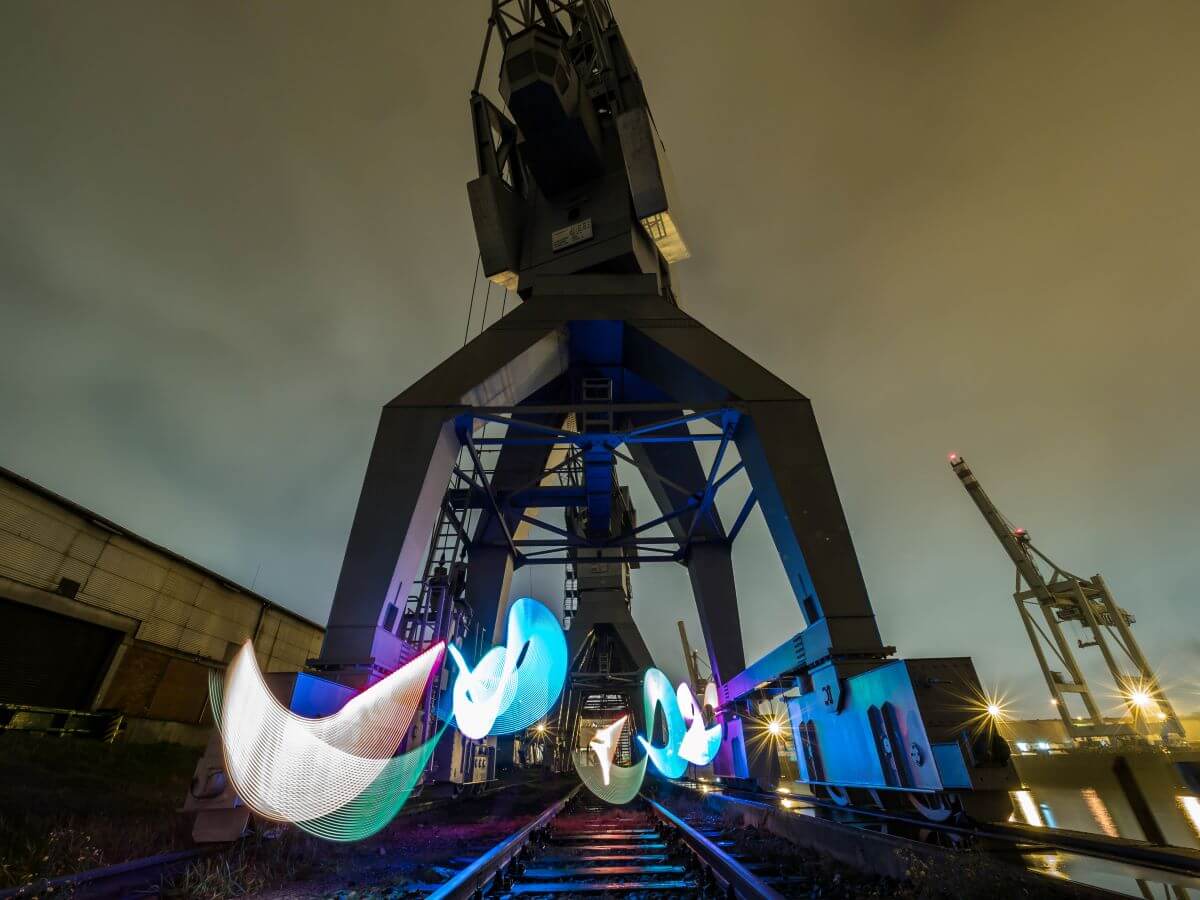Light painting has become a popular type of photography in recent years. The reason: Photos with impressive color accents are relatively easy to take. Color artist Olaf Schieche regularly gives workshops on this topic and uses, among other things, for this purpose Lumen sticks from Rollei. We accompanied him on a shoot.
1. What is important in light painting??
2. What would you recommend to a beginner??
3. What are the most common mistakes?
4. Tips you would give to your own beginner self from back in the day?
5. What camera settings would you recommend?
6. Which photo situations are the most exciting?
7. How did you get into light painting yourself??
8. Take a lot or a little equipment with you?
Bonus: Instructions for light painting with steel wool

1. What is important in light painting??
It depends on the right camera settings, ambient light and creativity. Without creativity you simply can't take beautiful pictures. It actually depends less on the equipment. The trick is to create something cool with what you have. It's mostly about creativity, location and camera angles. You should know the settings and how to work with light.2. WHAT WOULD YOU RECOMMEND TO A BEGINNER??
So, a beginner should, above all, know what equipment they should have with them. The camera must be able to use bulb mode. You need a decent one tripod, that can withstand the wind, not mini things that fall over just by looking at them Remote shutter release for bulb mode and also two or three flashlights. Small flashlights to large flashlights. You can actually build everything else yourself. In my opinion, that is also the art of light painting. Build it yourself with the funniest materials. For example heating insulation, duct tape, drinking cups or even bottles. Not only is it cooler to build these things yourself, but it's also simply cheaper. But that always depends on the respective tool. Sometimes you have to invest money.3. WHAT ARE THE MOST COMMON ERRORS?
Many people don't even understand what the aperture/camera settings have as a whole. Incorrect apertures are very often set. Or that you can't work with the autofocus in the dark. So you can't focus because too little light falls on the sensor. Many photographers are too hectic and don't think beforehand about what they want to include in the picture. And you also have to learn to move correctly with the light. Many people don't dare to do that at first. Of course it looks strange when you see someone dancing in the park with a glowing garbage bag. But you just have to get out of yourself and learn to create beautiful traces and ignore everything else.

| camera | exposure | ISO |
|---|---|---|
| Olympus OM-D E-M1 Mark II | 29 seconds at f/9 | 100 |
4. TIPS YOU WOULD GIVE TO YOUR OWN BEGINNER SELF?
Less is more. I always went way too colorful and used all sorts of colors. You can also just use blue tones or warm tones. Orange, yellow and red. I often wanted to achieve too much in one night. Light painting takes time, so you should be happy if you can create three pictures in one night.5. WHICH CAMERA SETTINGS WOULD YOU RECOMMEND?
Camera settings depend on where you are. If you have a certain basic lighting in the city, so that the sky is illuminated by the city, then Iso 100, the aperture usually at 8 and in bulb mode. If you shoot in RAW, you would also have to do a white balance. That's the beauty of light painting. You don't need all this nonsense. When I'm outside, I use different settings because I want to get as much light in as possible.6. WHICH PHOTO SITUATIONS ARE MOST EXCITING?
Personally, I think Lost Places are the coolest. You can combine old and new very well and let off steam. Or overall places that you wouldn't otherwise be able to get to. For example, last year I hiked up to Trolltunga, a rock formation in Norway. I took two pictures, slept upstairs and then hiked back down. You experience a lot overall when light painting. From customs to police to ghost hunters, everything was there. But I only came into contact with ghost hunters once, in the Klecker Forest south of Harburg. There is a megalithic grave where it is said that a witch lives there and where I did light painting. There I was standing on a rock with a lighted motorcycle helmet and laser sword. Suddenly a car stops and four people get out and ask me if I'm also looking for paranormal phenomena. They probably thought they had just discovered something paranormal, but that was just me.

| camera | exposure | ISO |
|---|---|---|
| Olympus OM-D E-M1 Mark II | 41 seconds at f/10 | 100 |
7. HOW DID YOU COME TO LIGHT PAINTING??
I was on holiday on Rügen in 2011 and had previously seen light paintings in the newspaper. They were stick figures and I thought I wanted to try them out. Then in the evening I walked down to the jetty, drank some wine, put the camera down and painted men, hearts and faces with a bicycle lamp and I was fascinated by it. Then I thought I would go ahead and develop it further.8. TAKE A LOT OR A LITTLE EQUIPMENT WITH YOU?
Principle number 1 when light painting: Always take more with you than you need. It could be that you have a spontaneous inspiration, which is why I always have my most important suitcases with me, my flashlight case and the tool case that contains the accessories. And then you can start.
BONUS: HOW DOES LIGHT PAINTING WITH STEEL WOOL WORK?
As a bonus, here is a guide to light painting with steel wool.
It is probably the fastest and easiest method for this type of photography.
EQUIPMENT FOR LIGHT PAINTING WITH STEEL WOOL:
- Metal whisk or tea infuser
- metal chain
- Dark clothing
- Lighter or D-block battery
- Steel wool (the finer, the better) fineness levels range from 0 (very coarse) to 0000 (very fine)
- The finer the wool, the more sparks fly
- Suitable location (preferably nothing flammable nearby and no glass panes because the sparks can burn through glass
- Puddles of water can be a good addition Reflections
- It is better not to work with steel wool in strong winds because the sparks can glow
PREPARATION:
- Attach the chain to the whisk or tea infuser in a fireproof manner (because it is hot up to 1,000 C))
- Loosen steel wool so that it is not packed so tightly (oxygen)
- Then pack in a tea strainer or whisk
- Light steel wool and slowly start swinging
LIGHT PAINTING:
- Set the camera's bulb mode
- Use aperture 6-11
- Focus manually because autofocus doesn't work in the dark
- View the result and readjust if necessary

